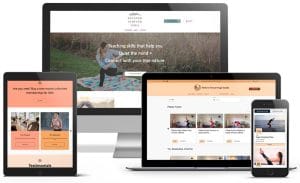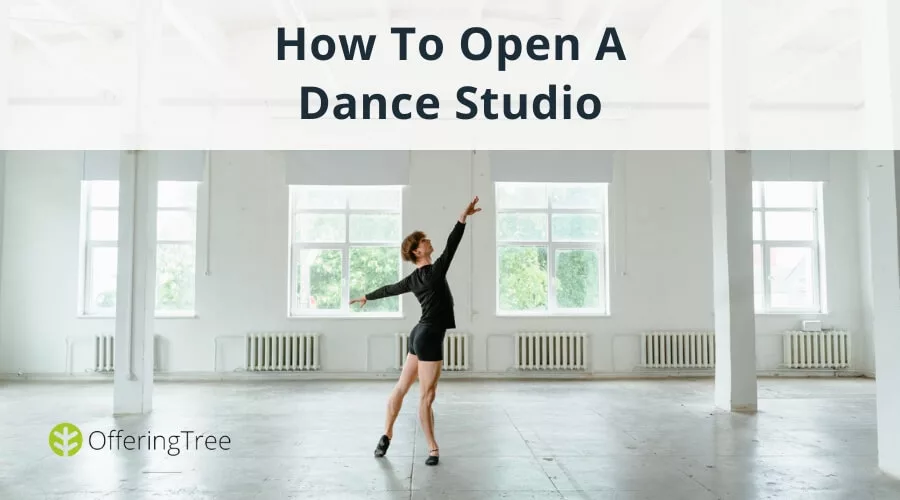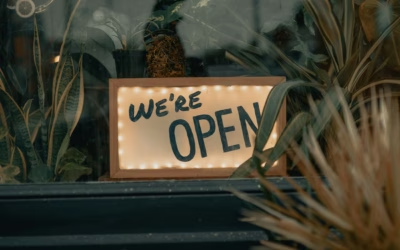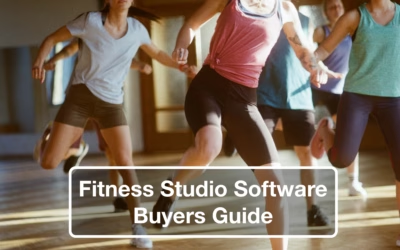Many dancers, no matter the type of dance they practice, dream of opening up their own studio. This lets them share their craft and passion with the world. However, figuring out how to open a dance studio on your own can be daunting.
Navigating the steps to open your own studio doesn’t have to be stressful. Luckily, this post explains what you need to do in only a few quick steps so that you can launch your new studio and share your love of dance with kids and adults alike. Let’s get started.

Looking to create a website for your new dance studio? OfferingTree’s all-in-one software can help.
How To Open Your Own Dance Studio
You may be wondering – just what does it take to open a dance studio? When it comes to starting any business, there’s more that goes into it than simply registering your LLC.
However, owning a dance studio comes with many benefits beyond sharing your love of dance with others. In fact, the dance industry is worth $4.7 billion in the United States. Economically, it’s a great time to learn how to run a dance studio and teach your craft.
There are multiple dance studio essentials you need to be aware of. The most important steps in opening your own place include:
How does OfferingTree compare to MindBody?

Feel like Mindbody is a bit complicated and expensive? See how OfferingTree is the easy button for running your studio!
Conduct Market Research
The first step for how to open up a dance studio is to spend lots of time doing market research. It’s important to figure out what other studios offer, what you can offer instead, what the local market is like, and what will make you stand out.
Depending on how familiar you are with the dance industry, this step may take anywhere from a month or two up to half a year. If you have friends, families, or mentors who have gone through the process before and know how to open a dance academy, they can be invaluable resources as well. Make sure you still conduct your own research, however, as the industry has probably changed a bit since your mentor opened their studio.
Create A Business Plan
After you have conducted your research, it’s time to draft a business plan. This can be called your “opening a dance studio checklist” because it should have everything you need to do and want to accomplish to start your business. What kind of dance classes do you want to teach? What licenses are needed to start a dance studio? What do your budget and finances look like? Questions like this can help you create a quality and reliable business plan.
Make sure you write a mission statement for your studio as well. This is the bottom line of the actions you’ll take, the purpose of your business, and how you can serve your dance clients. Also, set reasonable and attainable goals for yourself if possible – you don’t have to accomplish everything in a month.
Secure Funding
Part of the dance studio requirements you came up with in your business plan should include funding. There are lots of odds and ends that really start to add up when you’re opening a dance studio. Some things that you should be aware of as you’re figuring out your dance studio budget include:
- Business license costs, permits, and any other certifications you need
- Insurance
- Business cards, brochures, or any other promotional materials
- Website creation (which OfferingTree can help with!)
- Booking software for easy management of classes and clients
- Location or studio space rent
- Materials for dance studios (mirrors, bars, tights, shoes, towels, etc.)
Managing a dance studio can be tiresome when using multiple softwares and systems. OfferingTree’s all-in-one booking and website management software can help. With our powerful analytics and email marketing tools, you can rest assured that you’re reaching the right audience. Don’t let the hassle of managing your business hold you back.
Once you figure out what type of funding and how much to fulfill your fitness business plan for a dance studio, you can start to figure out how you’ll secure the money. You can take out a small business loan with the bank, opt for private funding, or use some of your own savings (or all three). At this point, however, you’ll also need a business tax ID number to be registered with the state.
Choose A Location
Finding a dance studio building to house your studio in is an important part of the process. You will have to determine how much dance space you’ll need, where you want to be located, and if you one day hope to expand.
There are many things to think about when you look into a potential location. If your studio is mainly going to cater to children, proximity to a school, library, or park would be best. Or, if you want to offer online classes, making sure you have a room dedicated to that would make sure other classes don’t get disrupted.
A few other ideas to think about when it comes to considering a location include:
- Safety: How safe is the area? If it’s unsafe, will it deter people from coming?
- Parking: Does it offer suitable parking for parents, students, or staff?
- Other Criteria: How many classrooms will you need? Will you want to grow your studio later? How much storage is necessary?
Take into consideration rent, utilities, and natural light as well. And truly, if you can’t find anything that fits your needs, building a dance studio could work instead – as long as it’s within the budget!
Obtain Licenses And Permits
As mentioned before, obtaining the correct licenses and permits is something else to think about when you look into how to start a dance studio. At this stage, you should have some of the necessary licenses, such as a business license and tax number, but there may be others you haven’t considered yet. Owning a dance studio may also require:
- State & local business permits
- Music licensing, depending on the types of classes and music you’ll be offering
- Certificate of occupancy, stating that all local and state regulations, building codes, and zoning laws have been met
- Various types of insurance, which may vary by state and studio location
Purchase Equipment And Supplies
Owning a dance studio requires all sorts of equipment, supplies, and miscellaneous needs. It’s best to look into acquiring the bigger purchases as soon as possible, such as mirrors or barres. Some of this may be to be customized to your space, which takes time and money.
Make sure you shop around to find the supplies that are within your budget. While you don’t need to buy state-of-the-art stereo equipment, make sure you don’t skimp out, either. Some of the most important supplies you may need include:
- Wall mirrors
- Stereo or sound equipment
- Sound-proofing, depending on the type of building and number of classes you’ll have
- Barres
- Office supplies
- Lighting
- Computer or software equipment
- Shelves or lockers for students and staff
- Dance flooring, depending on the type of class (tap, jazz, modern, etc.)

Offering quality equipment and classes can entice and retain new dancers.
Hire Staff And Launch Your Studio
The last thing you need to do before launching your studio is hire the staff you need. Depending on how large your studio is going to be, you may not need to hire anyone at first. Eventually, however, you may need more dance instructors or office staff to keep things running smoothly (and to give you some time off).
If you know anyone else in the dance industry, you can ask around to see who may be a good fit for your needs. Make sure your potential staff has the right education and qualifications for what they’ll teach. Also, give them an outline of what their duties will be, how often they’ll be needed to work, and what their contract and pay will look like.
Now that you’ve done everything on the back end to open your studio, it’s time to open up for business! However, your job isn’t done yet. Learning how to open a dance studio also includes:
- Marketing your studio and offerings
- Meeting and engaging with the community
- Maintaining client relationships
- Monitoring and improving operations
Marketing Your Studio And Offerings
You can market your studio before you even open by sending out flyers, emails, or social media blasts to get the word out. After you’re officially open, you can curate more personalized and detailed content for your target market. This will help keep you top-of-mind for new dancers.
Meeting And Engaging With The Community
Becoming more than just a name on a billboard or business sign will help show the community you’re authentic. Really drive your message and passion home by meeting with parents, talking to existing dancers, and offering community events as well.
Maintaining Client Relationships
After you find your clients, retaining them is another part of the battle. Offer incentives that will keep them intrigued and coming back. You can also offer things like a student showcase at the end of the year, group classes, or a free month of classes for prospective clients. Find something that works for you and stay authentic as well.
OfferingTree can give you a one-stop shop for all your needs with our “business in a box” software.
Monitoring And Improving Operations
Chances are that the operation plan you started with will need to be fine-tuned to fully encapsulate your needs. It’s okay if your original dance studio business plan needs a bit of tweaking — this actually shows that you’re shifting the needs of your type of business to fit your clients and their needs. This may include hiring more staff, changing the class times offered, changing how much you spend on a certain supply, or a myriad of other operational needs.

Manage Your Dance Studio Using OfferingTree’s All-In-One Software
If you ever wondered, “what do I need to open a dance studio?”, OfferingTree has you covered. These seven steps can put you on the right path to opening up your dream studio and sharing your passion with the world.
OfferingTree is passionate about helping gym, fitness center, and dance studio business owners work towards creating a community all of their own. Our “business in a box” software can start you on the right path to promoting your classes online and taking charge of your marketing analytics. Our software also helps you with appointment scheduling, money management, and client communication. Start a free 14-day trial or schedule a demo today.




